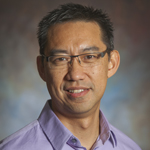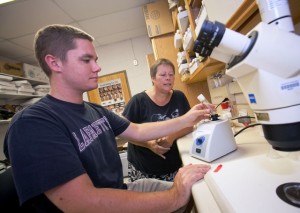The Biology Department welcomed Lafayette’s first computational biologist this semester, Eric Ho. Having a dedicated faculty member is a sign of the College’s commitment to a growing field that is already heavily researched in the College’s labs and classrooms.

Eric Ho
As an assistant professor of biology, Ho also has an affiliated appointment with the Computer Science Department. He is planning to create an up-to-date curriculum that will give students a comprehensive picture of the field “from sequence analysis to protein structure to phylogeny.” He hopes that this curriculum will inspire students to incorporate more computational elements into their junior and senior research projects. Lafayette has also equipped Ho’s research lab with a high-performance computing facility.
“Biologists know the research questions, but they may not have the necessary computational skills to solve it,” he says. “On the other hand, computer scientists have the skills to build computational tools, but they may not be able to choose the right problems to solve. Thus, computational biology provides the partnership opportunities for biologists and computer scientists to work with one another to create impactful solutions for complex biological problems.”
Many students and professors on campus are taking part in research merging biology and computational methods. Elaine Reynolds, associate professor of biology, has two ongoing projects. The first aims to understand how the pattern of active connections in the brain determines its ability to process information. The second involves creating a computational model of a cell-to-cell interaction during neural development that determines whether a cell becomes a neuron or a skin cell.
“Data in biology is often collected and analyzed with the aid of computers and if you want to look at complex biological systems, you often can use modeling as a tool to help sort out the effect of any single component,” explains Reynolds. “Modeling allows us to take a complex system, make changes in the program that change the interactions between cellular components, and predict the role of the component in the system.”

Professor Elaine Reynolds works with Blaine Caslin ’13 in her Kunkel Hall lab.
Reynolds believes that having Ho as a resource will provide new opportunities for students and faculty.
“Dr. Ho has formal training and research skills in biology, math, and computer science and has the expertise to teach this field to our students within the context of their biology courses,” she says. “Our students will get a more complete view of the field rather than just the parts I might have some experience in within my work.”
Jeffrey Pfaffmann, associate professor and head of computer science, sees the ever-expanding potential that computers have to analyze data and assist in solving research problems.
“Computational biology is important because it represents the future of all data-intensive fields,” he says. “Before digital computers existed, humans were sometimes ‘called computers,’ where they were doing complex numerical work with pencil and paper. With computers we are free of this menial work and can think about the important problems.”
Pfaffmann also stresses the importance for students since computational techniques are becoming part of mainstream biology.
“Having faculty like Eric Ho allows students access to this computational world and provides them essential understanding of how computers are used to solve problems. Computers are everywhere; being able to fully utilize these devices will allow their users a greater ability to reach any goal they wish to achieve.”

